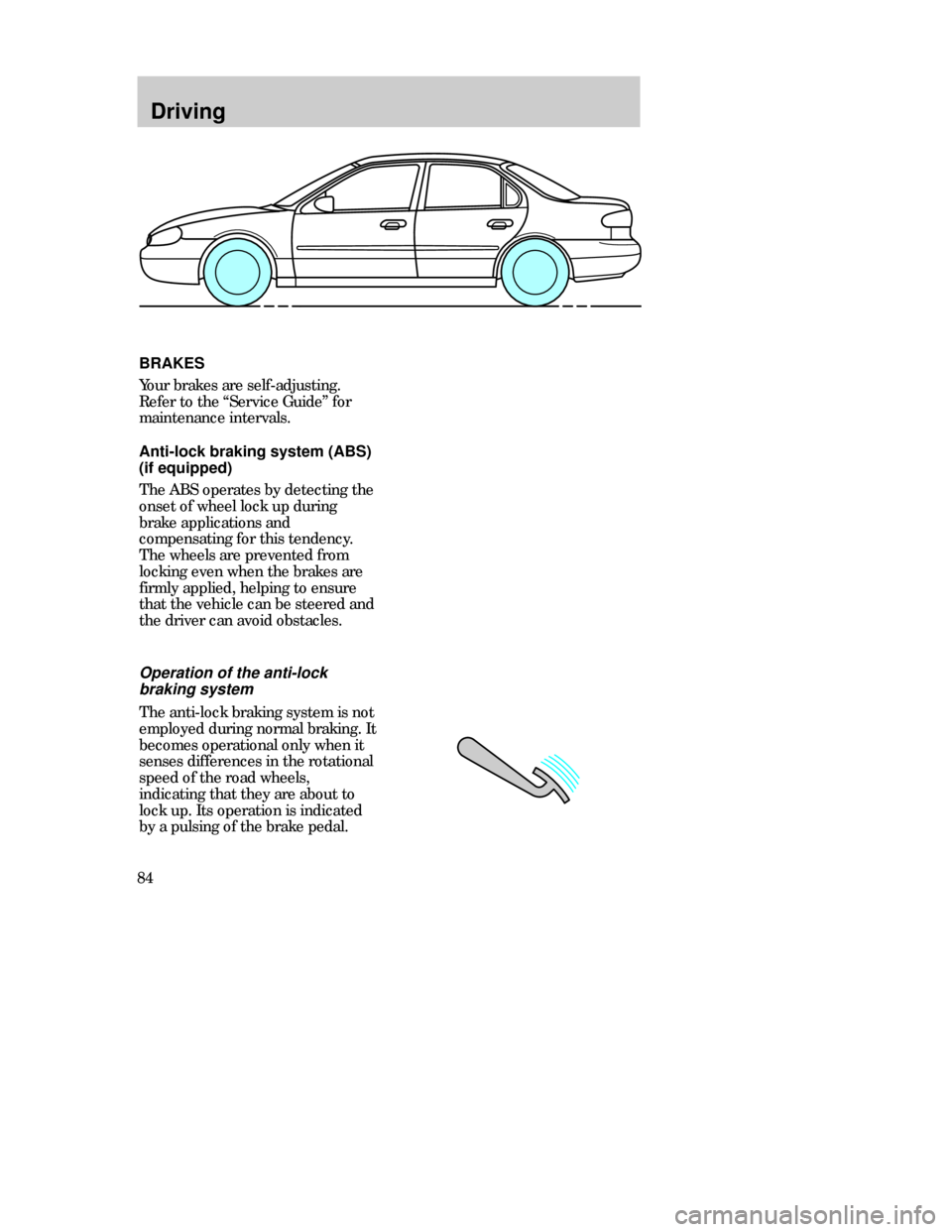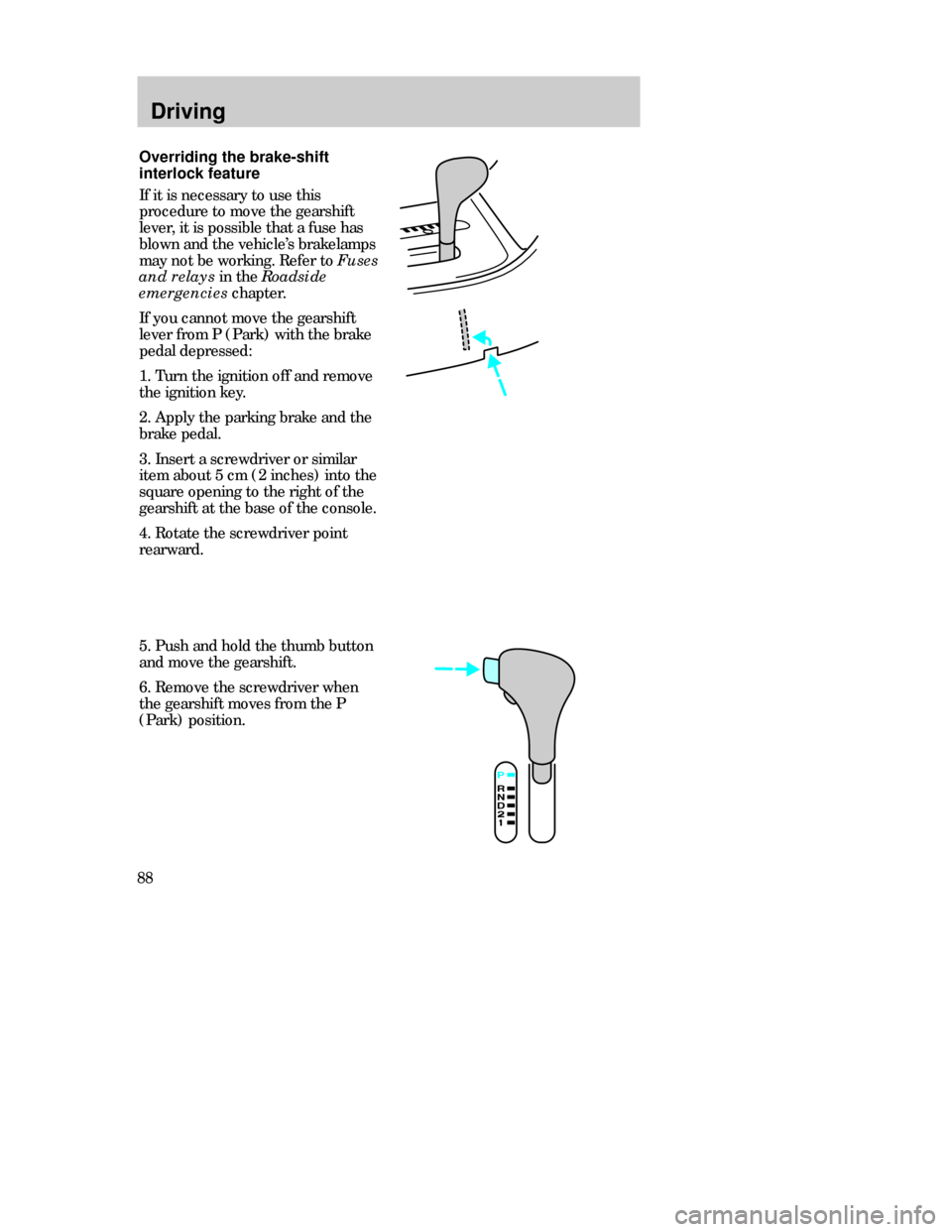Mercury Mystique 1998 s Manual Online
Manufacturer: MERCURY, Model Year: 1998, Model line: Mystique, Model: Mercury Mystique 1998Pages: 196, PDF Size: 1.65 MB
Page 81 of 196

Starting
81 3. Turn the key to the onposition
(without turning the key to start).
Make sure the following lights
illuminate briefly. If a light fails to
illuminate, have the vehicle
serviced by your dealer or a
qualified service technician.
•If the driver’s safety belt is
fastened the warning light does
not illuminate.
BRAKE
CHECK
ENGINE
CDW IVA1_2 Starting en MM 5/15/97 7:50 PM Page 81
Page 82 of 196

Starting
82STARTING THE ENGINE
1. Turn the key to the start
position (4) without pressing the
accelerator pedal and release as
soon as the engine starts. The key
will return to the on (3) position.
3
4
21
2. If the engine does not start
within five seconds, wait ten
seconds and try again.
3. If the engine does not start in
two attempts OR the temperature
is below -12°C (10°F), depress the
accelerator pedal and start the
engine while holding the
accelerator pedal down. Release
accelerator pedal when the engine
starts.
Vehicles equipped with the 2.0 l
engine: If the engine fails to start,
continue to crank with the
accelerator depressed about 1/4 of
the way down and hold that
position until the engine starts.
DO NOT crank for more than
30 secondsor you could damage
the starter.
4. After idling the engine for a few
seconds, apply the brake and
release the parking brake
CDW IVA1_2 Starting en MM 5/15/97 7:50 PM Page 82
Page 83 of 196

Starting
83 USING THE ENGINE BLOCK
HEATER (if equipped)
An engine block heater warms the
engine coolant, which improves
starting, warms up the engine
faster and allows the heater-
defroster system to respond
quickly. It is strongly recommended
if you live in a region where
temperatures reach –23°C (–10°F)
or below.
For best results, plug the heater in
at least three hours before starting
the vehicle. Using the heater for
more than three hours will not
harm the engine, so the heater can
be plugged in the night before
starting the vehicle.
To prevent electrical shock,
do not use your heater with
ungrounded electrical systems or
two-pronged (cheater) adapters.
CDW IVA1_2 Starting en MM 5/15/97 7:50 PM Page 83
Page 84 of 196

Driving
84BRAKES
Your brakes are self-adjusting.
Refer to the “Service Guide” for
maintenance intervals.
Anti-lock braking system (ABS)
(if equipped)
The ABS operates by detecting the
onset of wheel lock up during
brake applications and
compensating for this tendency.
The wheels are prevented from
locking even when the brakes are
firmly applied, helping to ensure
that the vehicle can be steered and
the driver can avoid obstacles.
Operation of the anti-lock
braking system
The anti-lock braking system is not
employed during normal braking. It
becomes operational only when it
senses differences in the rotational
speed of the road wheels,
indicating that they are about to
lock up. Its operation is indicated
by a pulsing of the brake pedal.
CDW IVB1-10Driving en MM 5/15/97 7:51 PM Page 84
Page 85 of 196

Driving
85
Two important
rules when
braking in
emergencies with
ABS:
1.
Apply full force
on both brake
and clutch pedal
(if equipped).
Braking with ABS
•In an emergency, apply full force
on the brake pedal. In vehicles
with manual transaxles, you must
also depress the clutch pedal.
The anti-lock braking system will
be activated immediately,
allowing you to retain full
steering control of your vehicle
and, providing there is sufficient
space, will enable you to avoid
obstacles.
•We recommend that you
familiarize yourself with this
braking technique. However,
avoid taking any unnecessary
risks.
2.
Steer around the
obstacle. No matter
how hard you brake,
steering control is
maintained.
CDW IVB1-10Driving en MM 5/15/97 7:51 PM Page 85
Page 86 of 196

Driving
86Parking brake
To engage the parking brake:
Pull the handle upward.
To release the parking brake:
1. Press and hold the release
button.
2. Pull the handle upward to
disengage the brake.
3. Push handle downward to the off
position.
Always set the parking brake
fully and make sure that the
gearshift is securely latched in P
(Park) (automatic transaxle) or in
1 (first) (manual transaxle).
To prevent personal injury,
do not release the parking
brake while outside the vehicle.
CDW IVB1-10Driving en MM 5/15/97 7:51 PM Page 86
Page 87 of 196

Driving
87 Automatic transaxle
(if equipped)
Vehicles equipped with an
automatic transaxle are equipped
with a brake-shift interlock feature
that prevents the gearshift lever
from being moved from the P
(Park) position unless the brake
pedal is depressed.
TRANSAXLE OPERATION
Putting your vehicle in gear
You must push the thumb button to
move the gearshift to the position
you choose.
To operate:
1. Start the engine.
2. Depress and hold the brake
pedal.
3. Move the gearshift lever out of P
(Park).
CDW IVB1-10Driving en MM 5/15/97 7:51 PM Page 87
Page 88 of 196

Driving
885. Push and hold the thumb button
and move the gearshift.
6. Remove the screwdriver when
the gearshift moves from the P
(Park) position.
Overriding the brake-shift
interlock feature
If it is necessary to use this
procedure to move the gearshift
lever, it is possible that a fuse has
blown and the vehicle’s brakelamps
may not be working. Refer to
Fuses
and relaysin the Roadside
emergencieschapter.
If you cannot move the gearshift
lever from P (Park) with the brake
pedal depressed:
1. Turn the ignition off and remove
the ignition key.
2. Apply the parking brake and the
brake pedal.
3. Insert a screwdriver or similar
item about 5 cm (2 inches) into the
square opening to the right of the
gearshift at the base of the console.
4. Rotate the screwdriver point
rearward.
CDW IVB1-10Driving en MM 5/15/97 7:51 PM Page 88
Page 89 of 196

Driving
89 The console-mounted gearshift will
lock when you turn the key to the
lock position. When the gearshift is
in any position except P (Park),
the ignition key cannot be turned
to lock or removed from the
steering column. To remove the
key, the gearshift lever must be in
P (Park).
Once the gearshift is secure in the
desired position, release the brake
pedal and use the accelerator as
necessary.
Driving
Never leave a vehicle
unattended while it is
running.
•P(Park)
Always come to a complete stop
before shifting into P (Park). This
locks the transaxle and prevents
the front wheels from rotating.
•R(Reverse)
The vehicle only moves backward.
Always come to a complete stop
before shifting in or out of R
(Reverse).P=Park. . . . . . . . . . . . . .
R=Reverse. . . . . . . . . . .
N=Neutral. . . . . . . . . . . .
D=Drive: Gear 1 to 4
with overdrive. . . . . .
Gear 1 to 3
with overdrive
cancelled. . . . . . . . . .
2=Gear 2. . . . . . . . . . . .
1=Gear 1. . . . . . . . . . . .
CDW IVB1-10Driving en MM 5/15/97 7:51 PM Page 89
Page 90 of 196

Driving
90
•D (Overdrive)
Note that the vehicle’s gearshift is
console-mounted on the floor. The
transaxle control switch (TCS) is
located on the gearshift handle.
The transaxle control indicator
light (O/D light) is located on the
instrument panel.
Overdrive is not shown on the
display, but is the default mode for
the D gearshift position. This is the
normal driving mode for the best
fuel economy. The transaxle
operates in gears one through four.
The O/D light is off (not
illuminated) during normal vehicle
operation.
Overdrive can be deactivated by
pressing the transaxle control
switch (TCS) located on the
gearshift handle. The O/D OFF
indicator light will illuminate in the
instrument cluster.
•N(Neutral)
The wheels of the transaxle are not
locked. Your vehicle will roll freely,
even on the slightest incline, unless
the parking brake or brakes are on.
CDW IVB1-10Driving en MM 5/15/97 7:51 PM Page 90